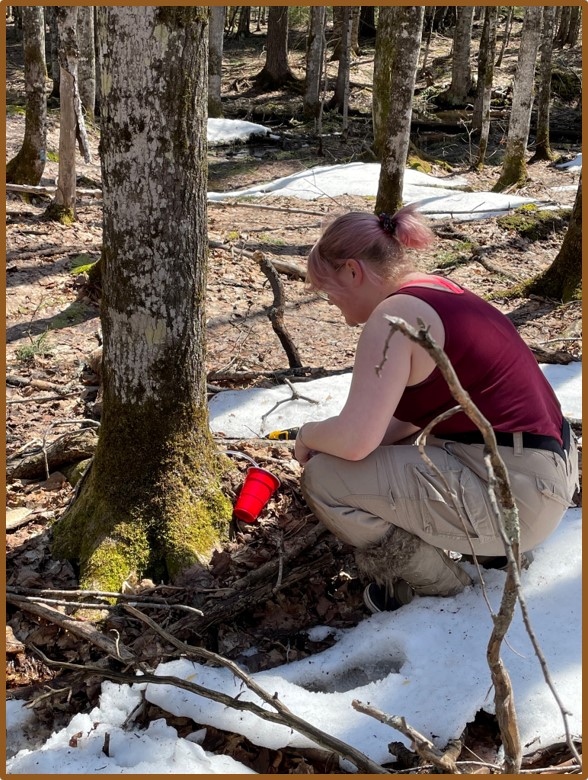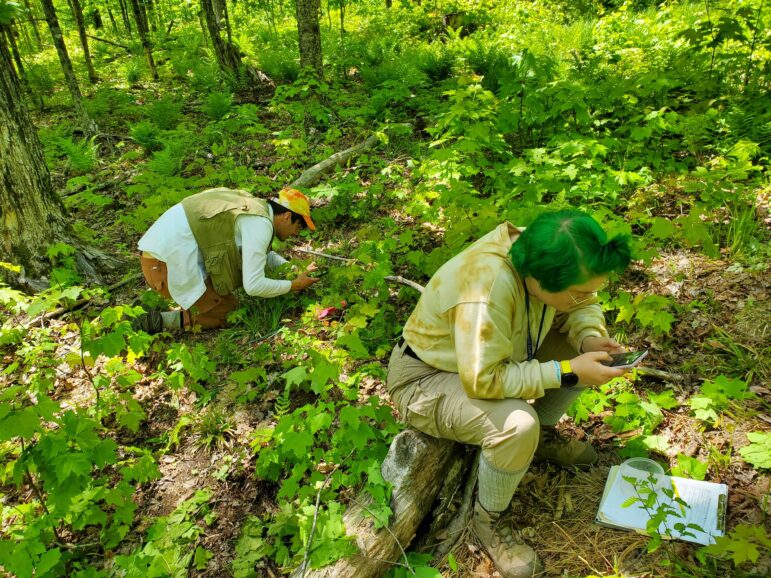
Tara Bal
Michigan Tech graduate student Shelby Lane-Clark checks on maple sap being collected to test for chemical differences in forests with different amounts of earthworms presentBy Eric Freedman
Capital News Service
LANSING – You’re wrong if you think the lowly earthworm has little to do with the health of Michigan’s hardwood forests.
To the contrary, “exotic” – non-native – earthworms can have “widespread and complex effects” on individual trees and overall forest health, according to researchers from Michigan Technological University and the New Zealand Forest Research Institute.
“For example, we are currently evaluating sugar maple dieback and decline in the northern Great Lakes region and relating it to evidence of earthworm activity,” they said in a recently published study.
All the earthworms that the researchers found in the Upper Peninsula, northern Wisconsin and eastern Minnesota – representing about 10 species – are unwelcome invaders, according to Tara Bal, the lead researcher and an assistant professor of forest health at Michigan Tech.
There are no native earthworms in the Northern hardwood forests because glaciation over the past 100,000 years scraped off the topsoil and bedrock, she said. One or two native earthworm species live in the southernmost parts of Michigan, with more found in Indiana and Ohio.
Earthworms naturally move less than 26 feet a year, but they’re rapidly spread by such human activity as building roads, dumping live bait near boat launches and transporting them in mud and dirt found on tires, the study said.
“Though they have a long introduction history in some urbanized areas, earthworms continue to invade new forested areas,” it said.
“They move super-slowly on their own,” Bal said.
Like invasive plants, invasive earthworms are most often found along roadways.
“Earthworm invasions” harm forest health, including making it more difficult to regenerate desirable tree and plant species, scientists say.
They don’t directly kill trees, Bal said, “but when they are introduced they do all kinds of things to soil that makes trees more susceptible” to other threats, such as climate change that causes more runoff, drought and periods of heavy precipitation.
The study said other invasive species and grazing by deer can exacerbate the impact of earthworms.
The team’s sugar maple research is underway at 120 evaluation plots on private industry and public land.
Those in Michigan are in the U.P. counties of Marquette, Baraga, Houghton and Keweenaw, as well as in eastern Minnesota and northern Wisconsin. Research at those plots found significant evidence that earthworm activity correlates with sugar maple dieback.
Sugar maples are the dominant hardwood species in the region. Bal said she’d like to expand her work to other species like American basswood, but other species are generally limited to a few scattered trees in a stand.
Forest management plans of government agencies, private property owners and nonprofit organizations should track whether earthworms are present on their lands and consider their potential impacts, the study said.
To prevent earthworm invasions and spread power washing vehicles and harvesting equipment should be power washed before they’re moved, the study said. It also recommends installing boot scrubbers at trailheads, improving informational signs and public awareness and using local material to build and grade roads.
Most of the team’s research money comes from the U.S. Forest Service and the U.S. Department of Agriculture. Much of the work is done in Michigan’s Hiawatha and Ottawa National Forests, Wisconsin’s Chequamegon-Nicolet National Forest and Minnesota’s Superior National Forest.
“It is important to continue supporting efforts to evaluate and understand earthworm invasion progression and understand their relationship to other factors impacting northern hardwood forests,” the study said.

Mattison Brady
Michigan Tech graduate students Manuel Anderson and Shelby Lane-Clark check identification of plants while surveying for the impact of non-native earthworms.